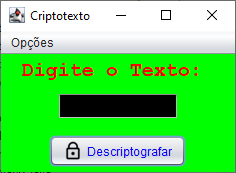Boa noite Pessoal!
Estou com um problema… Eu gostaria de fazer um botão de um segundo frame que eu fiz, mostrar o resultado de um JTextField do primeiro frame.
PRIMEIRO FRAME
package N2;
public class testn3 implements ActionListener {
JTextField t;
JPanel p1;
JPanel p2;
JPanel p3;
JLabel lb;
JButton b;
JFrame frame;
JMenuBar menuBar;
JMenu menu1;
JMenuItem tuto;
JMenuItem sair;
private void montaFormulario() {
menuBar = new JMenuBar();
menu1 = new JMenu("Opções");
menuBar.add(menu1);
tuto = new JMenuItem("Tutorial", new ImageIcon("img/tuto2.png"));
sair = new JMenuItem("Sair", new ImageIcon("img/sair2.png"));
menu1.add(tuto);
menu1.add(sair);
frame = new JFrame("Criptotexto");
frame.setJMenuBar(menuBar);
p1 = new JPanel();
p2 = new JPanel();
p3 = new JPanel();
lb = new JLabel("Digite o Texto:");
lb.setText( "<html><font color=FF0000>Digite o Texto: </font><font color=00FF00>");
t = new JTextField(10);
Icon icone = new ImageIcon("img/pad.png");
b = new JButton("Descriptografar", icone);
b.setForeground(Color.BLUE);
t.setForeground(Color.WHITE);
b.addActionListener(this);
tuto.addActionListener(this);
sair.addActionListener(this);
Font fonte = new Font("Courier New", Font.BOLD,20);
lb.setFont(fonte);
p1.add(lb);
p2.add(t);
p3.add(b);
p3.setBackground(Color.green);
p2.setBackground(Color.green);
p1.setBackground(Color.green);
t.setBackground(Color.black);
frame.add(p1, BorderLayout.NORTH); frame.add(p2, BorderLayout.CENTER); frame.add(p3, BorderLayout.SOUTH);
frame.setBounds(100, 100, 250, 180);
frame.setDefaultCloseOperation(JFrame.EXIT_ON_CLOSE);
frame.setVisible(true);
}
public void actionPerformed(ActionEvent e) {
if(e.getSource() == tuto) {
JOptionPane.showMessageDialog(null,"Exemplos de Entrada:\n\n\n1) NoTApasCAL\r\n"
+ "2) atEQUEatabELATERMINE\r\n"
+ "3) zoEIrrRRRRa");
}
else if(e.getSource() == sair){
System.exit(0);
}
else {
new SecondFrame();
// int j;
// String entrada;
// String saida= “”;
// entrada = t.getText();
// for(j=entrada.length()-1; j>=0; j–) {
// if(entrada.charAt(j) >= 96)
// saida += entrada.charAt(j);
// }
// if(saida == “”) {
// JOptionPane.showMessageDialog(null, “Digite o Texto!”,“Error!”, JOptionPane.ERROR_MESSAGE);
// }
// else
// JOptionPane.showMessageDialog(null, saida,“Descriptografado Com Sucesso!”, 3);
}
}
public static void main(String[] args) {
try {
for (javax.swing.UIManager.LookAndFeelInfo info : javax.swing.UIManager.getInstalledLookAndFeels()) {
if ("Nimbus".equals(info.getName())) {
javax.swing.UIManager.setLookAndFeel(info.getClassName());
break;
}
}
} catch (ClassNotFoundException ex) {
System.err.println(ex);
} catch (InstantiationException ex) {
System.err.println(ex);
} catch (IllegalAccessException ex) {
System.err.println(ex);
} catch (javax.swing.UnsupportedLookAndFeelException ex) {
System.err.println(ex);
}
new testn3().montaFormulario();
}
}

SEGUNDO FRAME
public class SecondFrame {
JFrame f = new JFrame(“Sucesso!”);
JPanel p = new JPanel();
JPanel p2 = new JPanel();
JLabel lb = new JLabel(“Texto Descriptografado Com Sucesso!”);
JButton b = new JButton(“Mostrar”);
public SecondFrame() {
p.add(b);
p2.add(lb);
f.add(p, BorderLayout.CENTER);
f.add(p2, BorderLayout.NORTH);
f.setDefaultCloseOperation(JFrame.DISPOSE_ON_CLOSE);
f.pack();
f.setVisible(true);
}
}
